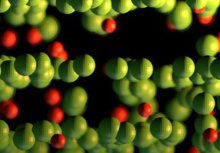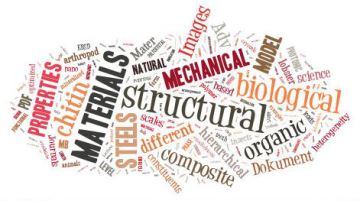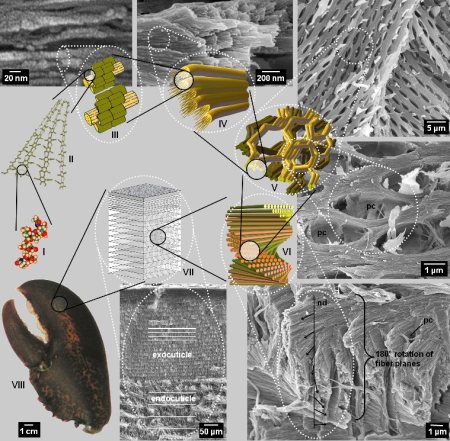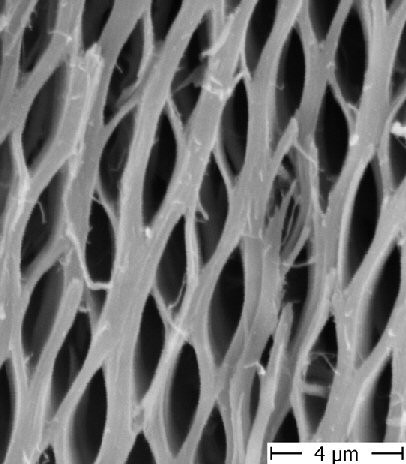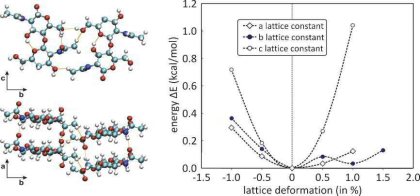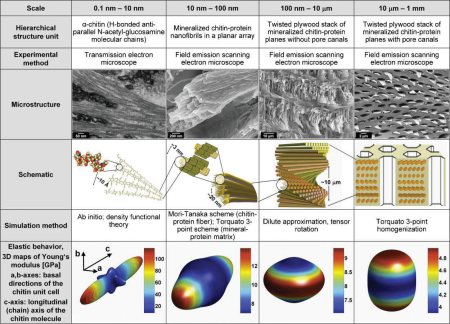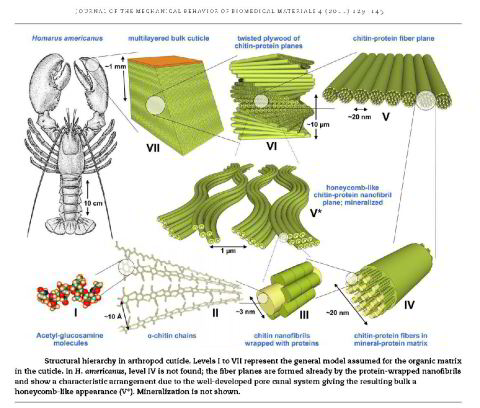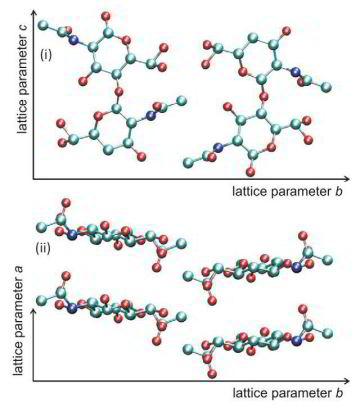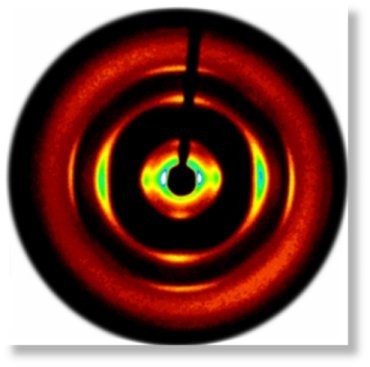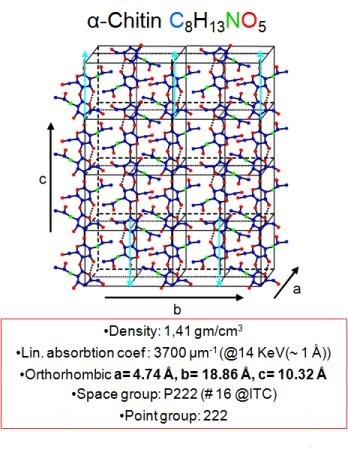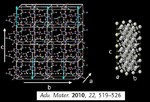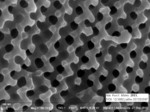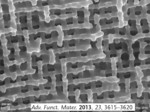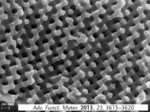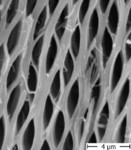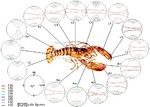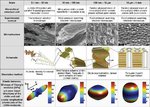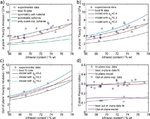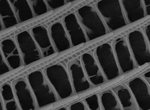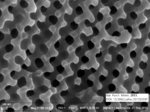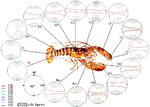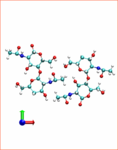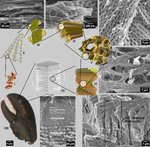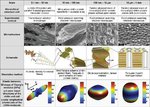Chitin: the structural building material of insects and arthropods: structure and properties
Introduction to chitin
Chitin is an insoluble linear polymer of ß-1,4-linked N-acetylglucosamine residues.
Chitin is the most abundant nitrogen-bearing organic compound found in nature: it is a common constituent of insect exoskeletons, shells of crustaceans and fungal cell walls.
Chitin is the second most common biomass. It is produced by a variety of marine animals, insects and fungi. Three polymorphs of this polysaccharide, the polymer of the N-acetyl-D-glucosamine, are known.
In mineralized biological tissue either the alpha or beta form is present.
Owing to its crystalline forms chitin can be studied by XRD.
In the course of evolution nature developed materials based on organic–inorganic nanocomposites with complex, hierarchical organization from Angstroms to millimeters tailored via molecular self-asse
Muliscale-Modeling-Conference-Singapur-R[...]
Microsoft Power Point-Präsentation [25.2 MB]
Chitin-based materials science
Structural materials have always been a key factor for the development of human society, starting with the use and modification of natural materials and, nowadays, culminating in production of a multitude of highly specialized synthetic materials, based on a broad variety of raw materials. The increasing demand for new, sophisticated multifunctional materials has brought natural structural composites into focus, since these have been optimized in their functions in a long selection and adaptation process during evolution. Biological structural materials differ fundamentally from most man-made structural materials, in being inherently structurally heterogeneous. This heterogeneity arises from a multitude of different constituents already at the molecular level, including mainly various organic molecules, such as proteins or sugars, but also inorganic matter, mostly in the form of calcium-based minerals. The constituents are produced and/or provided by the organisms, which also control the formation of subassemblies. These can have different compositions, shapes, sizes, and spatial distribution, leading to the hierarchical organization found in most structural biological materials throughout the flora and fauna, such as wood, vertebrate bones and teeth, mollusk shells, arthropod exoskeletons, and skeletal elements of other invertebrates. The complexity of these materials is further increased by different chemical compositions in different positions of the same structure, as the degree of mineralization, fluid content, and the resulting variation in the type and density of internal interfaces. This structural heterogeneity implies that the mechanical properties of such materials are also heterogeneous at different length scales. The highest level of hierarchy in biological structural materials can be either the whole organism, such as, for example, a tree, its smaller subunits, like the stem or single branches, or, like in the case of animals, a single bone of a vertebrate or an appendage segment of an arthropod. These functional units as a whole have ideal mechanical properties for their individual purposes, which are optimized for the occurring loads. The overall mechanical properties of a functional unit rarely reflect the bulk properties of the material ingredients constituting them, but rather depend on their geometry and topological arrangement. In some biological materials, such as bone or teeth, the mechanical properties of the bulk material are well investigated. Already at this macroscopic scale significant variations have been observed between different sampling positions within a specimen, and correlations have been shown to specific loading requirements.[4] At the macroscopic level, the mechanical response to external loads represents the integral result of the mechanical behavior of the individual composite constituents, and their hierarchical structural arrangement on different length scales in the bulk material. This structural heterogeneity and the decreasing size of the constituents at the lower hierarchy levels are exactly the point where the study of biological structural materials becomes very challenging. It also implies that the mechanical properties that can be measured in such materials depend strongly on the observed length scale, and may vary from one hierarchical level to another. Depending on the structure, mechanical anisotropy also occurs on different hierarchical levels. This progress report focuses on microstructure and the macromechanical properties of themineralized parts of the exoskeletonof an arthropod, our model organism Homarus americanus, the American lobster, as an example for a hierarchically structured biological material designed to withstand mechanical loads.
Chitin reprints
Adv. Mater. 2010, 22, 519-526
Revealing the Design Principles of High-Performance
Biological Composites Using Ab initio and Multiscale
Simulations: The Example of Lobster Cuticle By Svetoslav Nikolov, Michal Petrov, Liverios Lymperakis, Martin Friak,
Christoph Sachs, Helge-Otto Fabritius, Dierk Raabe, Jorg Neugebauer
Advanced Matererials 2010, 22, 519–526 M[...]
PDF-Dokument [540.3 KB]
In the course of evolution nature developed materials based on organic–inorganic nanocomposites with complex, hierarchical organization from Angstroms to millimeters tailored
via molecular self-assembly.[1–3] Such materials possess outstanding stiffness, toughness, and strength related to their low density, while the mechanical characteristics of their
underlying constituents are rather modest.[2,4] This remarkable performance is a consequence of their hierarchical structure, the specific design at each level of organization, and the
inherent strong heterogeneity[4] resulting in the accommodation of macroscopic
loadings by different deformation mechanisms at different length scales. Therefore, to understand the macroscopic mechanical properties of the tissue, one should take into account
its structure–property relations at all length scales down to the molecular level. To date, this key challenge has been only partly addressed due to severe obstacles in obtaining
mechanical and structural data at the nanometer scale. The mechanical properties of important proteins and biominerals as well as some details about their exact structure are still
unknown. A powerful tool to overcome these difficulties and to better understand the structure–property relationships in biomaterials is multiscale modeling encompassing all length
scales.[3,5] Some progress in the development of multiscale structure–property relationships for mineralized tissues has been achieved by combined modeling and experimental approaches
applied to bone,[4] nacre,[6] and fish skin armor.[7] However, these approaches do not explicitly integrate a molecular-level description and use continuum mechanics at the meso- and
macroscale (e.g., finite element analysis) coupled with experimental data obtained, for example, by nanoindentation. A more advanced multiscale modeling has been proposed
for collagen-based biomaterials,[3,5] where molecular-dynamics calculations are applied to individual tropocollagen molecules,[8] while the deformation behavior of single collagen
fibrils[9] at the mesoscale and of soft collagen tissues[10] at the macroscale has been modeled by adopting continuum-mechanical concepts. First-principles calculations, based on
quantum mechanics and density functional theory (DFT), that are free of adjustable or experimental parameters have recently evolved as a versatile and accurate tool to study
fundamental biological mechanisms and structures on the atomic scale. However, due to the complexity and the hierarchical nature of biomaterials, the application of these techniques is
still out of reach to study macroscopic mechanical behavior. We therefore propose a new approach
combining ab initio calculations with hierarchical homogenization that allows us to study structure–property relations including all length scales.
To describe the key concepts of this approach and to demonstrate its applicability we choose a tissue containing chitin, the second most abundant natural polymer on earth
after cellulose. Chitin-based composites serve as exoskeleton material for more than 90% of all animal species, a fact that demonstrates their extremely adaptive potential to realize a
vast range of natural
materials. In this Communication, the cuticle of a large crustacean, the lobster Homarus americanus, is discussed as a model material. The crustacean cuticle is one of the oldest
natural materials for structural and armor applications. Crustacea, such as crab, lobster, crayfish, or shrimp, are already present in the
fossil record of the Early Cambrian period (515 Myr ago) and, thus, among the most successful animals living on earth.[11] One of the reasons for the versatility of crustaceans is their
functional body design, featuring a hard, chitin-based mineralized exoskeleton. Another consideration for choosing the cuticle of H.
americanus is that extensive experimental data are available on its microstructure and crystallographic texture.[12–19] These data are
required as an input to construct the multiscale approach, while the experimentally measured mechanical properties of the cuticle[14–17] allow to quantitatively validate the accuracy of
our model.
Robustness and optimal use of design principles of arthropod exoskeletons studied by ab initio based multiscale simulations
Journal of the Mechanical Behavior of Biomedical Materials
Volume 4, Issue 2, February 2011, Pages 129–145
S. Nikolov, H. Fabritius, M. Petrov, M. Friák, L. Lymperakis, C. Sachs, D. Raabe, J. Neugebauer
Journal Mechanical Behavior Biomedical M[...]
PDF-Dokument [1.1 MB]
Most biological materials with structural functions in the animal kingdom consist of an organic matrix of structural biopolymers like
collagen and chitin which is modified and reinforced with different proteins and in many cases also with biominerals. The most prominent
examples of such materials, like the bones of vertebrates, the exoskeletons of arthropods, and mollusk shells, are known to possess excellent mechanical properties (e.g., in
terms of stiffness-to-density ratio and fracture toughness). The origins of these properties have become the subject of intensive research in recent years (Vincent, 1990; Currey, 1996; Weiner
and Addadi, 1997; Vincent and Wegst, 2004; Ashby and Wegst, 2004; Tai et al., 2007; Buehler and Wong, 2007; Ortiz and Boyce, 2008; Chen et al., 2008; Meyers et al., 2008; Al-Sawalmih et al., 2008;
Fabritius et al., 2009). It has been observed that the specific design and properties at the nanoscale contribute significantly to their macroscopic properties (Nikolov et al., 2010). Evidently,
the overall properties depend on the specific microstructure at all levels of hierarchy. However, in particular, the properties at small length scales are experimentally hard, if not impossible, to
access due to methodological constraints. Hence, multiscale modeling that can systematically describe and investigate materials properties from the atomistic scale up to the macroscopic level has
become a major approach to tackle the structure–property relations of biological organic/inorganic nanocomposites and has been applied to bone, mother of pearl, lobster cuticle, and related
heterogeneous natural compounds (see, e.g., Vincent and Wegst, 2004;
Ashby and Wegst, 2004; Raabe et al., 2005, 2006; Fratzl and Weinkamer, 2007; Nikolov and Raabe, 2008). In addition to modeling fully differentiated structural composites, the
approach has been successfully applied to model the mechanical properties of individual constituents and to explain the structure–property relations on increasingly complex
structural hierarchy levels. For non-mineralized soft tissues, important work on collagen fibril and tissue mechanics based on a multiscale approach linking molecular to continuum
scales
(Buehler, 2008; Tang et al., 2009) showed that there is a strong dependence of the fibril (tissue) response on nanoscopic structural features such as the density of crosslinks
between neighboring collagen molecules. Most multiscale models use fixed averaged values for the properties and volume fractions of the constituents (structural polymers,
proteins, minerals) to predict the overall
tissue properties. However, in reality, due to structural variations such as caused by different stages of growth, molt cycle, injuries, and synthesis heterogeneity, the properties and
the volume fractions of the tissue constituents may vary considerably locally. Thus, an important question is how much the overall tissue properties change upon such structural
variations of the building blocks on the small length scale. Tackling this question helps to better understand the robustness of biological tissue design. Experimentally validated
physics-based
multiscale models are an excellent vehicle to conduct such structure–property tolerance studies as the different ingredients and their behavior can be systematically varied. In a very
recent work, a similar sensitivity analysis using multiscale modeling has been applied to bone (Reisinger et al., 2010).
The fact that the structure and mechanical properties of some constituents in biological hard tissues (e.g., proteins) are not well understood at present suggests an additional benefit
of theory-assisted structural design analysis. It is
therewith possible to identify at least the most probable order of magnitude of some of their properties by the comparison of corresponding multiscale predictions with
experimental data. A similar question arises with respect to biomimetic considerations. The aim of reproducing certain properties of biological matter in a synthetic material does
not necessarily require copying the original biological structure but rather understanding the mechanical principle behind the material and replacing the underlying building blocks or
their topological connectivity. A corresponding multiscale modeling approach can help to identify the relevant key ingredients with respect to a certain property and the
tolerance of the overall material behavior against structural variations. We also address that current experimental observations suggest that among a set of possible structural
variations real biological materials often reveal an optimal use of their ingredients regarding the best possible performance for a given composition. In this work, we
investigated these two questions of structural tolerance and optimal use taking mineralized load-bearing parts of the chitin-based exoskeleton of the crustacean Homarus
americanus as a case study. The exoskeletons of all Arthropoda are formed by the cuticle which covers the entire animal and is locally modified in microstructure and chemical
composition to perform all the functions required to meet the ecophysiological strains encountered by the organism. The cuticle represents a multilayered
chitin–protein- based composite whose microstructure is ierarchically organized (Fig. 1). On the low levels of structural hierarchy, this general scheme appears to be
valid for all arthropods. On the higher levels, significant differences can be found both in structural organization and in chemical composition between different taxa and even in
closely related species (Neues et al., 2009; Hild et al., 2008, 2009). Crustaceans, for instance, reinforce the hard, load-bearing parts of their cuticle by incorporating various
biominerals. The shell of the American lobster contains variable amounts of amorphous (ACC) and crystalline (calcite) calcium carbonate (Boßelmann et al., 2007). This renders the arthropod cuticle a biological
multi-functional composite that can be used as a template for nano-to-macro-scale hierarchical modeling.
Recently, we proposed a hierarchical model for the elastic properties of mineralized lobster cuticle using (i) ab initio calculations for the chitin properties and (ii) hierarchical homogenization performed in a bottom-up order through all length scales. It has been found that the cuticle possesses nearly extremal, excellent mechanical properties in terms of stiffness that strongly depend on the overall mineral content and the specific microstructure of the mineral–protein matrix. In this study, we investigated how the overall cuticle properties changed when there are significant variations in the properties of the constituents (chitin, amorphous calcium carbonate (ACC), proteins), and the volume fractions of key structural elements such as chitin–protein fibers. It was found that the cuticle performance is very robust with respect to variations in the elastic properties of
chitin and fiber proteins at a lower hierarchy level. At higher structural levels, variations of design parameters such as the volume fraction of the chitin–protein fibers have a significant influence on the cuticle performance. Furthermore, we observed that among the possible variations in the cuticle ingredients and volume fractions, the experimental data reflect an optimal use of the structural variations regarding the best possible performance for a given composition due to the smart hierarchical organization of the cuticle design.
Adv. Funct. Mater. 18 (2008) 3307–3314 c[...]
PDF-Dokument [584.4 KB]
Thermochimica Acta 463 (2007) 65-68 The composition of the exoskeleton of two crustacea: The American lobster Homarus americanus and the edible crab Cancer pagurus F. Boßelmann, Romano, H. Fabritius, D. Raabe, M. Epple
Thermochimica Acta 463 (2007) 65–68 comp[...]
PDF-Dokument [300.8 KB]
Crustaceans constitute a widespread class of organisms of both marine and land-dwelling species. They possess an exoskeleton [1] that stabilizes the whole body of the animal and also serves for protection against predators. In the case of lobsters and crabs, the claws are part of the exoskeleton optimized to serve as a cutting tool. The exoskeleton of crustaceans [2] is a biomineralized [3–6] structure which consists of an organic matrix (in this case -chitin) together with an inorganic mineral, in this case mostly calcium carbonate [7]. This composite has a distinct microstructure which gives it an optimal performance with respect to mechanical strength (for protection) and flexibility (for movement). Raabe et al. have analysed this microstructure and found a strongly hierarchical twisted plywood structure [8–10] and pronounced crystallographic textures (preferred orientation distributions of calcite and chitin [11]. This paper reports the chemical composition of these exoskeletons, following our study of the exoskeleton (cuticle) of land-dwelling woodlice [12,13].
More specific in this project the exoskeletons of the American lobster Homarus americanus and of the edible crab Cancer pagurus were analysed with structural and chemical methods. The exoskeletons consist of crystalline magnesian calcite in the form of nanocrystals (domain size about 20 nm), amorphous calcium phosphate (ACP), and -chitin. The composition varies among different parts of the skeleton and also between the two species. Differences are related to the mechanical requirements and biological escape behaviour of the animals. The finger and claw are strongly mineralized and very hard. The shell of the body (the carapace) is less mineralized and more elastic. The lobster, as a mobile, fast-swimming animal, typically escapes from a predator whereas the crab clings to the ground and burrows into the sand. Consequently, the shell of the lobster is less mineralized (and therefore lighter and less hard) than the shell of the crab.
The exoskeleton of the lobster is a hierarchically organized nano-composite material consisting of organic chitin–protein fibers associated with inorganic calcium carbonate.
Journal of Structural Biology 161 (2008)[...]
PDF-Dokument [2.8 MB]
Biological photonic structures evolved by insects provide inspiring examples for the design and fabrication of synthetic photonic crystals. The small scales covering the beetle Entimus imperialis are
Adv Funct Materials Wu chitin photonik c[...]
PDF-Dokument [13.5 MB]
PDF-Dokument [4.0 MB]
Biological photonic structures evolved by insects provide inspiring examples
for the design and fabrication of synthetic photonic crystals. The small scales
covering the beetle Entimus imperialis are
Advanced-Functional-Materials-Wu-photoni[...]
PDF-Dokument [2.2 MB]
